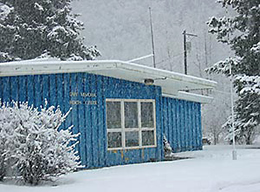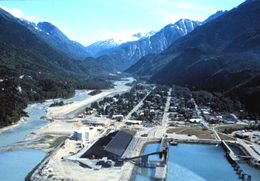 |
| In this Issue: | |||||||
HRSA Grants Official Makes Unexpectedly Long Visit to Alaska Health Center
Pam was very impressed with the “first-rate care” Leeth and Cameron gave her. “They couldn’t have been nicer or more caring,” she said. “And that was before they knew I was from HRSA!” As she waited for her trip to Anchorage, Pam noticed how much her face hurt. “I was wind burned from the ship and the salt from my tears really stung.” She asked if they had any skin lotion with some aloe. “I did her one better,” Cameron told Inside HRSA. “I love to garden, so I keep two aloe plants in the clinic. I picked two leaves, slit them, and put the gel on her face.” “It was heavenly,” Pam said. “And so unexpected in the rugged wilderness of Alaska.” Skagway is indeed the wilderness, and Pam’s case was far from unique. Surrounded by towering snow-capped mountains on three sides, Skagway is only accessible by air or sea. There are just 862 full-time residents, but cruise ships bring in over 800,000 visitors in the summer. Leeth estimates that the clinic sees 10 or 12 visitors a week during tourist season with an injury due to a fall or other health emergency. Of those, roughly two or three need to be flown out for further treatment. “The good thing about having two nurses on duty is that one can take care of the patient while the other focuses on making the travel arrangements,” Cameron explained. As Pam awaited her flight to Anchorage, the clinic’s director, Glenette Christian, came by for a brief chat. “When Pam said she was from HRSA, Lynne got word to me immediately,” said Christian. “We all know how important HRSA is to this clinic.” The Dahl Clinic is funded by HRSA as part of President Bush’s Health Center Initiative to improve access to treatment in hard-to-reach areas. When the plane finally arrived, Pam and her husband boarded along with another visitor who had heart problems. “My husband is a retired Navy pilot,” Pam said, “and he appreciated how skillfully the pilot took off from a short runway with mountains everywhere.” Two nurses were on board to care for the patients during the two-hour flight. At Providence Hospital in Anchorage the specialists determined that Pam needed a partial artificial shoulder replacement. Because the recovery period is so long after such arduous surgery, they advised stabilizing her condition in Anchorage over several days and then flying home for the operation. Four days later Pam flew with her husband from Anchorage to Seattle and then, finally, home. Her shoulder replacement surgery was done at Baltimore Washington Hospital Center in Glen Burnie. Now she is convalescing at home. “I do some work from home, pecking away with one hand,” she said. “I can’t wait to start physical therapy to get back in action as soon as possible.” Looking back, Pam said, “I’m really proud of what HRSA is doing. It’s great to know what good people and what great care we provide for people in need. Most of the time we’re removed from that reality, but that’s what we are really about. I know, I experienced it first-hand.” |
|||||||

